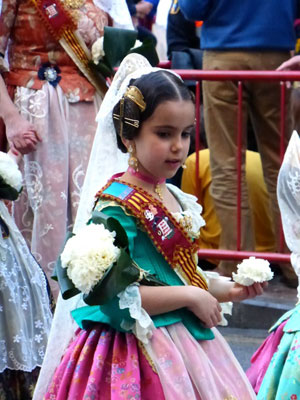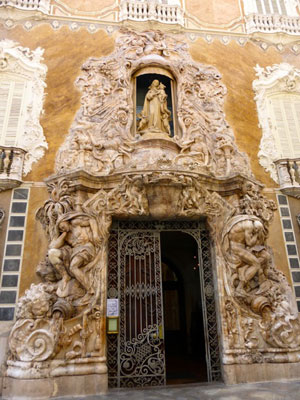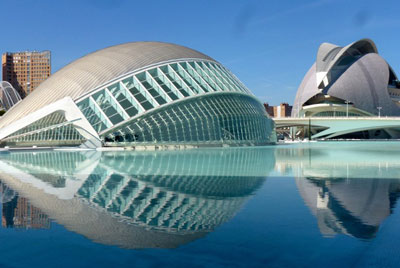Valencia’s fanciful Las Fallas festival
This article appears on page 6 of the December 2014 issue.
Valencia is the third-largest city in Spain; it’s a 2½-hour train ride from Madrid and one hour south of Barcelona, yet it gets little mention in guidebooks about the country. The city features a long, wide and not overdeveloped beach, spectacular modern architecture, a charming large center with many pedestrian-only streets, a UNESCO World Heritage Site and an amazing festival called Las Fallas. In fact, it was a chance viewing of a video clip about Las Fallas that lured my husband, Thom, and I to Valencia in March 2014.
Las Fallas was all we expected and more, but Valencia’s other charms made our stay of five days too short.
The festival
So what is Las Fallas? It is costumes, color, fireworks and Disneyesque satirical characters assembled at many intersections all over the city.
This traditional celebration is held in commemoration of Saint Joseph every March 15-19 and may have its origins in the Middle Ages, when carpenters and artisans burned scrap wood to celebrate the spring equinox. Eventually it coincided with the festival of Saint Joseph, the patron saint of carpenters.
The wood scraps gradually evolved into effigies and, finally, into the structures called fallas. The largest of the 350-plus structures are made of papier-mâché, wax, polystyrene, cork and wood and are packed with explosives. There are also numerous fallas infantiles, smaller fallas designed for children to enjoy.
The construction of each falla is a neighborhood project. A theme for the festival is selected as soon as the last one is over, and neighborhoods raise money to fund their elaborate constructions, which are now almost exclusively professionally made and very expensive. People also decorate the streets of their neighborhoods with lights that arch over the streets and with flags.
The themes of the individual fallas are traditionally satirical, lampooning anything or anyone: politicians, organizations, businesses, celebrities or society in general. During Franco’s long reign, the satirical content was censored, but now the fallas are often R-rated!
Each neighborhood has a tent near their falla for socializing as well as a group that parades in traditional costumes with a neighborhood band each day of the festival. This group also participates in the Offering of Flowers, a custom which was adopted at the time of the Spanish Civil War.
On the third and fourth days of the festival, each falla neighborhood proceeds in costume to take an offering of red or white carnations to a huge statue of the Virgin Mary, the base of which is eventually completely covered with flowers. This procession includes men, women and children in gorgeous traditional Fallas costumes.
Other traditional activities of the festival are La Despertà (which kicked off at 8 a.m. with bands and people lighting firecrackers and parading through the neighborhoods), La Mascletà (a barrage of firecrackers in each neighborhood that happens at 2:00 each day) and the nightly fireworks show, all featuring lots of noise.
On the last evening there is a parade known as the Fire Parade, with floats, costumes, rockets, street performances and music. The grand finale is the burning of all of the fallas, followed by the most spectacular fireworks display of all.
The individual characters on a falla are called ninots, and each year one ninot is voted to be placed in the Museum of the Fallas.
City sights
We spent a day and a half enjoying the other charms of Valencia as well, and they are myriad! At a minimum, one should visit the Palacio Marqués de Dos Aguas with its National Museum of Ceramics; La Lonja, a medieval building with Gothic architecture and memorable interiors; Valencia Cathedral, a blend of Gothic and Baroque styles; the Art Deco Central Market; the two remaining medieval city gates; the City of Arts & Sciences, and, of course, the beach.
After having visited three major museums in Madrid, we didn’t visit the two major museums in Valencia, but here is a brief description of our three favorites.
Housed in an 18th-century palace, Palacio Marqués de Dos Aguas features fully and elaborately furnished and decorated rooms along with a remarkable collection of ceramics, dating from ancient times to modern, including four plates by Picasso. My favorite exhibit was a reproduction of a typical Valencian kitchen with 18th- and 19th-century wall tiles, utensils and pottery.
La Lonja is a medieval merchants’ hall where silk and other commodities were traded. The Gothic central hall has four rows of slim, fluted columns supporting a vaulted ceiling; the adjoining halls have painted and coffered ceilings.
The Turia River, which used to surround the old section of town on three sides, was redirected in 1957 following a significant flood. A 5½-mile city park known as the City of Arts & Sciences now sits on the old riverbed.
Within this park are gardens, playgrounds, joggers, bikers and a spectacular assemblage of very contemporary buildings (primarily designed by noted Valencian architect Santiago Calatrava): the Palau de les Arts Reina Sofía, a multihall auditorium; L’Hemisfèric, an IMAX theater and planetarium; the Príncipe Felipe Science Museum; the Ágora, a multipurpose exhibition center, and Calatrava’s iconic bridge. A little distance on there is the Oceanografic, an aquarium.
Impressions
I wondered whether we would be put off by the crowds and the noise of the festival, as we don’t really enjoy either. Certainly, the old section was filled with people all five days of the festival — following the parades, viewing as many of the fallas as they could and filling the cafés. Amazingly, there was never an unpleasant situation.
This was a family occasion, without pushing, excess drinking or loud music, and the noise of the fireworks was limited by time and place. The only random explosions I heard were the little caps children put on the pavement and stepped on.
The night of the fires was our least favorite festival event, as much smoke was generated. Because all of the fallas are set afire at approximately the same time, you can really only pick one infantile and one large one to see in flames.
The crowds were festive, friendly and almost exclusively Spanish. Although an enormous amount of trash was generated, the human and mechanical sweepers were always working, so the city remained amazingly clean.
We spent our days walking the streets, peering down to the next intersection to spot another falla, photographing the displays from every angle, following the parades and visiting the sights mentioned previously.
On our fifth day, the day after the festival, we went out early to see the burnt remains of the fallas and were amazed to find that the streets were immaculate. Traffic had returned to the streets where the crowds had been walking, and life was back to normal. The only visible remnant was the beautiful flower-bedecked Virgin, which stood until the flowers died.
On that day we took a bus to the beach and walked the long beach promenade, seeking out the best Valencian paella (chicken and rabbit) at a beach restaurant. Found it!
The details
We flew nonstop from Chicago to Madrid on Delta. Getting from Madrid’s new, modern airport to the area of our hotel and the Atocha train station was easy, as an express bus went from the terminal to the Atocha train station.
We stayed three nights in Madrid before taking the train to Valencia.
There were several trains to Valencia from Atocha daily. I had researched the schedule before we left and selected one that worked best for us, typing it out. I handed the schedule to the man at the ticket window in Madrid and he seemed very pleased that I knew what I wanted. We got our tickets without difficulty, our charge cards accepted.
I used www.bahn.de/i/view/DEU/en/index.shtml to research our route. For more information, go to www.ricksteves.com/travel-tips/transporta tion/trains/online-schedules, which gives very detailed instructions for planning train trips. Rail Europe’s website (www.raileurope.com) is also helpful.
It was easy and pleasant to ride the trains, even in second (turista) class. A screen at the end of each car showed upcoming stations.
It seemed more like taking a plane; our train was called, we had our ticket scanned and our bags scanned, then we went to the indicated track to wait the short time until we boarded.
Instead of taking the train straight through to Valencia, we got off after an hour to visit Cuenca, a UNESCO World Heritage Site famed for its “hanging houses.” Old Cuenca, situated on the hill above New Cuenca, was walkable and charming, and we enjoyed a night at the beautiful Parador de Cuenca (Subida a San Pablo, s/n 16001) at a special senior rate of €135 ($169) including breakfast.
We traveled from the Cuenca station to the center of modern Cuenca by bus (which was waiting at the station) and transferred to another bus that took us to the Plaza Mayor of Old Cuenca. From there, we got directions from a local for our walk to the Parador de Cuenca. It was not a long walk, but it was not an obvious route.
Heading back to the station by taxi in the morning, we caught the same train we were on the day before, arriving shortly in Valencia. We had selected a hotel that was in the center of the Las Fallas action and within walking distance of the station.
The new station for high-speed trains, next to the old Art Deco station, was a longish walk from the hotel. I’d recommend taking a taxi if you are traveling with more than one roller suitcase per person.
Hotel Sorolla Centro (Convento Santa Clara, 5; www.hotelsorolla.com) was very convenient and honored our request for a quiet room. We slept well.
The hotels all hike up their rates during the festival. We paid €199 ($249) per night for the four nights of Las Fallas and €99 ($124) for our fifth night, all inclusive of taxes and a nice breakfast. The hotel staff was exceptionally friendly and helpful.
We returned to Madrid by train in the morning and had an afternoon and evening to enjoy the city before spending the night at Hotel Paseo del Arte (Atocha, 123), a 4-star Warwick hotel located a short walk from the station. Priced at a very reasonable €138, without breakfast, it was convenient for visiting the museums.
Our hotel for the first three nights we had spent in Madrid was the boutique Artrip (Valencia, 11), which cost €120 on weeknights and €140 on weekends, including taxes and a very nice breakfast. Our room was modern and comfortable, and the staff was superb. This hotel was not quite as well located for walking to/from the train station, museums or bars and restaurants, but it was otherwise very satisfactory.
This trip was so special that we’re already thinking of returning in 2015.





